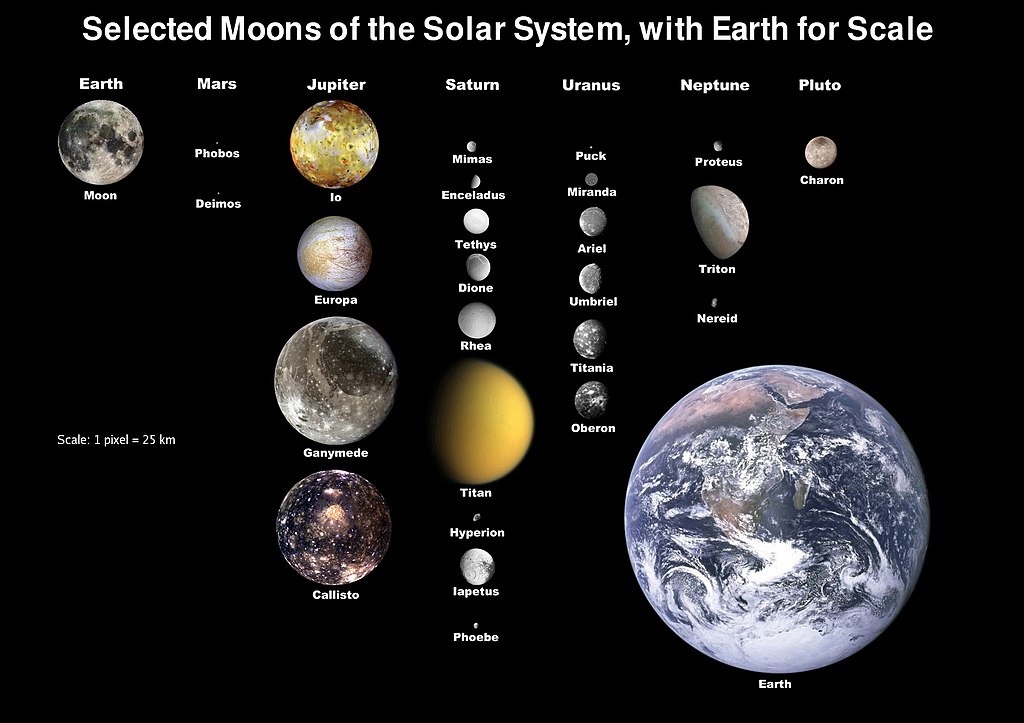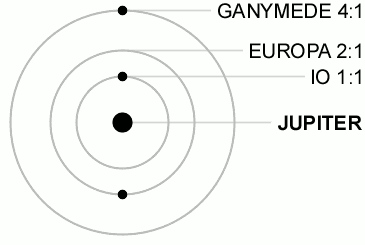- Required Reading: Lab 7, Appendix D (telescope operation). It is hard to understand equipment without first seeing and playing with it, but insofar as possible you should be ready to use the C8 telescopes.
- Read the Startup Presentation.
- Read the Post Mortem. Better before than after actually.
- IAL 15: Gas Giants:
The Galilean Moons of Jupiter
- Read a sufficient amount of the articles linked to the following terms etc. so that you can define and/or understand the terms etc. at the level of our class: C8 telescopes, Galilean moons (Io, Europa, Ganymede, Callisto), Jovian solar eclipses, Jupiter, Kepler's 3 laws of planetary motion, Kepler's 3rd law, occultation, opposition, orbit (orbital period, mean orbital radius, orbital resonance), shadow transit, tidal locking, umbra.

Caption: Jupiter's Galilean moons in collage.
The moons are in their right relative positions (inner to outer Io, Europa, Ganymede, Callisto), but not to scale. The images were taken by Voyager 1 in 1979 March.
Credit/Permission: NASA, 1979 / Public domain.
Download site: NASA: GRIN: Great Images in NASA.
Supplementary Lab Preparation: The items are often alternatives to the required preparation.
- Bennett (2008 edition): p. 73--78 on Kepler's 3 laws of planetary motion, p. 350--355 and p. A-16 on the Galilean moons of Jupiter.

Caption: Portraet des Erasmus von Rotterdam am Schreibpult.
Desiderius Erasmus (1466/69--1536) hitting the books.
Credit/Permission: Hans Holbein the Younger (c. 1497--1543), 1523 (uploaded to Wikipedia by Erik Moeller (User:Eloquence), 2005) / Public domain.
Image linked to Wikipedia.
The quiz might be omitted if it's not feasible or convenient. The students may or may not be informed ahead of time of quiz omission depending on the circumstances.
The quizzes in total are 40 % of the course grade. However, only the top five quiz marks are counted.
In preparing for a quiz, go over the Required Lab Preparation.
The Supplementary Lab Preparation (see above) could help, but is only suggested if you feel you need more than the required Required Lab Preparation.
There is no end to the studying you can do, but it is only a short quiz.
One to two hours prep should suffice.
There will be 10 or so questions and the time will be 10 or so minutes.
The questions will range from quite easy to challenging.
-
Some of the questions will be thinking questions. You will have to reason your way
to the answers.
The solutions might be posted at Jupiter Moons: Quiz Solutions. after the quiz is given. Whether they are or not depends on the circumstances of each individual semester.
- Check as needed:
- As usual for inside-outside labs, check the weather online at
NWS
7-day forecast, Las Vegas, NV in advance and
by personal visual inspection at/during the lab period.
The observations of the Galilean moons are only a small part of this lab.
So if weather is not good, just omit the observations.
The students will probably have another chance to observe Jupiter and the Galilean moons on another night just for fun.
- Since this is a
Galilean moons observation lab, you should
check that Jupiter is in the
current nighttime
sky:
- TheSky You'll have
to go to a computer with this
software installed.
- Sky & Telescope: This Week's Sky at a Glance
Scroll down to "This Week's Planet Roundup", but it is not all that great.
-
Sky map: Las Vegas, current time
Your's truly---after trying everything else first---has used the Customise page to make Fourmilab: Your Sky give a Las Vegas sky map at the current time.
Fourmilab: Your Sky is a bit tricky at first---not reading the instructions is a real hold-up---but you can use it to get a sky map above the horizon for any time and place.
I didn't set all possible options on. That would make the sky map too cluttered. But I did click on ecliptic-celestial equator, planets-Moon and constellation names.
- Latitude 36°10'30" N = 36.17500000 N
- longitude 115°08'11" W = 115.13638889 W
- PST=UTC-8
- UTC=PST+8
- PDT=UTC-7
- UTC=PDT+7
Caption: Sky map: Las Vegas, Nevada, current time when refreshed.
Location and time data for Las Vegas, Nevada:
The abbreviations above are explained by the following linked terms: Pacific Daylight Time (PDT), Pacific Standard Time (PST), Coordinated Universal Time (UCT).
The planets are labeled by the planet symbols:
-
Mercury ☿,
Venus ♀,
Earth ♁,
Mars ♂,
Jupiter ♃,
Saturn ♄,
Uranus ☉ with spear on top (⛢, ♅),
Neptune ♆,
ex-planet Pluto ♇
Alas and alack, the standard Uranus symbol has an HTML code, but it is not universally supported yet. So I give ☉ with spear on top (⛢, ♅), where the first bracketed item is what the unsupported code gives and the second bracketed item is the astrological Uranus symbol---which isn't much good for anything---but it is supported.
Credit/Permission: John Walker: Fourmilab: Your Sky, 2003 / Public domain.
Image linked to Fourmilab: Your Sky.
- TheSky You'll have
to go to a computer with this
software installed.
- You will need to set up the
C8 telescopes
on the roof before the lab period and review their usage well in advance if needed.
Alignment is NOT needed since Jupiter is easy to find by hand.
See Telescope Operating Procedure for procedures and tips.
Since the observations are such a small part, probably only 8 C8 telescopes need to be set up even if all three sections are doing Jupiter Moons.
The sections can cycle through using them.
- For good observations, 40 mm eyepiece
should be used for finding Jupiter
and a smaller
focal length
eyepiece (maybe 12.5 mm)
should be used for observing
Jupiter's
Galilean moons
You can set out the appropriate smaller focal length eyepieces on the cart for students to get and return.
Make sure the students are instructed to loosen, but not remove, the screws when changing eyepieces.
If they remove the screws, the screws may fall on the ground and be lost forever in the crevasses.
The 40 mm eyepieces should be back on the C8's at the end of the night.
Don't let the students walk off with eyepieces in their pockets.
- The CCD camera
will have to be set up by someone if any images are to be taken.
Maybe there won't be any images or maybe you will not need to do the set up.
See CCD Camera Instructions if the CCD camera is to be set up.
- You will need to get protractors and rulers out of the
storeroom BPB 252.
They'll be on a shelf somewhere.
There probably are NOT enough for all groups in all sections to have their own protractor and ruler.
Maybe grab 5 or each section---don't take too many or the other lab instructors will become hostile.
You should put out the List of Tricks for C8 Telescopes.
You also need to assign each group a particular Galilean moon for the lab to be their Galilean moon for the Clea Galilean moons software part.
You could do this later or put on sheets of paper on the tables for the groups to collect as they form.
- Startup Presentation: You will need to go over the Galilean moons, Kepler's 3 laws of planetary motion, the use of a protractor, the Clea Galilean moons software and the use of the Excel spreadsheet---all in 10 minutes or so.
The astro labs are active learning environments. Students quite rightly get impatient with lengthy intros.
- Later just before going outside you will need to give a brief intro.
Point out to them the List of Tricks for C8 Telescopes---and tell the students to leave the Tricks sheets for collection at the end of the night---they can be re-used.
Remind them especially of telescope shutdown for the night if they are the last users of the C8's for the night---if they don't do it, someone else will---you?
Then give a brief description/reminder of what they will be doing with the C8's which is just to sketch Jupiter and the Galilean moons.
They will have to find and center Jupiter for themselves since the C8's will probably not be aligned.
Tell them about changing eyepieces.
- Startup Presentation: You will need to go over the Galilean moons, Kepler's 3 laws of planetary motion, the use of a protractor, the Clea Galilean moons software and the use of the Excel spreadsheet---all in 10 minutes or so.
- Logon to the computers.
- Hand back last weeks lab reports and quizzes as students come in insofar as possible.
The ones not handed back can be left on the front desk for students to collect at their leisure.
- Start promptly at 7:30 pm.
- Give tonight's agenda in brief and announce next week's lab and whether the lab is inside or inside-outside.
- Give the Post Mortem on the previous lab.
- Give the quiz if there is one (usually there is).
It will typically be 10 questions in 10 minutes.
- Now tell the students to form new groups and send them the computers and have them launch
Mozilla Firefox,
click on the bookmark jeffery astlab,
click Lab Schedule/Lab 7: Jupiter Moons,
and scroll down past the foxes.

Caption: "Red foxes (Vulpes vulpes) at the British Wildlife Centre, Horne, Surrey, England." (Slightly edited.)
Credit/Permission: © Keven Law, 2008 / Creative Commons CC BY-SA 2.0.
Image linked to Wikipedia.
- Objectives: To study
the orbits
of Jupiter's
Galilean moons
Io,
Europa,
Ganymede,
and
Callisto.
Learn something about
Kepler's 3rd law of planetary motion.
Make observations of Jupiter
and the Galilean moons if possible.
- This lab will usually be done with
Jupiter in the
night sky so that
observations are possible, weather permitting.
We can check whether Jupiter is in the night sky on the sky map below
The planets that are currently in the sky are illustrated in the sky map below.
The planets are labeled by the planet symbols:
- Latitude 36°10'30" N = 36.17500000 N
- longitude 115°08'11" W = 115.13638889 W
- PST=UTC-8
- UTC=PST+8
- PDT=UTC-7
- UTC=PDT+7
Caption: Sky map: Las Vegas, Nevada, current time when refreshed.
Location and time data for Las Vegas, Nevada:
The abbreviations above are explained by the following linked terms: Pacific Daylight Time (PDT), Pacific Standard Time (PST), Coordinated Universal Time (UCT).
The planets are labeled by the planet symbols:
-
Mercury ☿,
Venus ♀,
Earth ♁,
Mars ♂,
Jupiter ♃,
Saturn ♄,
Uranus ☉ with spear on top (⛢, ♅),
Neptune ♆,
ex-planet Pluto ♇
Alas and alack, the standard Uranus symbol has an HTML code, but it is not universally supported yet. So I give ☉ with spear on top (⛢, ♅), where the first bracketed item is what the unsupported code gives and the second bracketed item is the astrological Uranus symbol---which isn't much good for anything---but it is supported.
Credit/Permission: John Walker: Fourmilab: Your Sky, 2003 / Public domain.
Image linked to Fourmilab: Your Sky.
- Nicolaus Copernicus (1473--1543)
put the planets in their correct place to 1st order.
Here a modern diagram of the inner Solar System plus Jupiter.
The diagram is to scale.
Emphasize to the students the utility of the astronomical unit (AU) as the natural unit for Solar System distances.
Copernicus himself first discovered the true relative Solar System distances in terms of the astronomical units.
This was made possible by his adoption of a heliocentric solar system model.
No one before Copernicus knew what those relative distances were.

Caption: The inner Solar System plus Jupiter which is in the outer Solar System.
The Asteroid Belt and Jupiter Trojan asteroids are shown. The diagram is to scale.
This is a view from the North Pole side of the Earth's orbital plane which, in astro-jargon, is the ecliptic plane. This is the customary way to view the Solar System face-on.
The planets and almost all asteroids orbit counterclockwise from this perspective. A very few asteroids orbit clockwise which is called retrograde motion.
The "Greeks" are the leading Trojans and the "Trojans" are the trailing Trojans---except that 617 Patroclus got into the "Trojan camp" and 624 Hektor got into the "Greek camp".
The astronomical unit (AU) is the mean Earth-Sun distance.
It is the natural unit for Solar System distances---no one grasps such distances in kilometers or miles---but the media keep quoting them mindlessly anyway.
In astronomical units the mean planet-Sun distances are as follows:
-
Mercury 0.38710,
Venus 0.72333,
Earth 1.00000,
Mars 1.52369,
Jupiter 5.2028333,
Saturn 9.53876,
Uranus 19.19139,
Neptune 30.06107,
ex-planet Pluto 39.52940.
In astronomical units, the Solar System size scale is comprehensible.
Credit/Permission: User:Mdf, 2006 (uploaded to Wikipedia by User:Dronemvp, 2007) / Public domain at least in USA.
Image linked to Wikipedia.
- The lab also touches on
Kepler's 3 laws of planetary motion.
- The planets orbit the
Sun in
ellipses with the
Sun at one
ellipse
focus.
- The planet orbital radiuses sweep out
equal areas in equal times.
This means the planets move faster the nearer they are to the Sun.
- The square of the
orbital period is proportional to the
cube of the
semi-major axis
of the elliptical orbit
(which is the definition actually of the
mean planet-Sun
distance).
Caption: The first two of Kepler's 3 laws of planetary motion illustrated compactly.
The 3 laws are:
The 3 laws also are exact for ideal systems (which we will not describe here).
Credit/Permission: © Han-Kwang Nienhuys (AKA User:Hankwang), 2007 / Creative Commons CC BY-SA 3.0.
Image linked to Wikipedia.
- The planets orbit the
Sun in
ellipses with the
Sun at one
ellipse
focus.
- From the image below, we can see that the
Galilean moons are
among the largest moons
of the Solar System---1st, 3rd, 4th, and 6th largest,
in fact---only the Moon (5th largest)
and Titan (2nd largest) break up their
dominance in size.
- Earth: the Moon (3474, 5th).
- Mars (see Martian moons): Phobos (22.2 km), Deimos (12.4 km).
- 243 Ida (an asteroid asteroid belt): Dactyl (about 1.5 km).
- Jupiter (see Jovian moons, Galilean moons): Io (3643, 4th), Europa (3122 km, 6th), Ganymede (5268 km, 1st), Callisto (4821 km, 3rd).
- Saturn: (see Saturnian moons): Mimas, Enceladus, Tethys, Dione, Rhea (1528, 9th), Titan (5152 km, 2nd), Hyperion, Iapetus (1469, 11th), Phoebe.
- Uranus (see Uranian moons): Puck, Miranda, Ariel, Umbriel, Titania (1577 km, 8th), Oberon (1523 km, 10th).
- Neptune (see Neptunian moons): Proteus, Triton (2707 km, 7th), Nereid.
- Pluto (ex-planet, dwarf planet, see Plutonian moons): Charon (1207 km, 12th).
- Eris (dwarf planet): Dysnomia (of order 300 km).

Caption: The major moons of the Solar System shown to scale with the Earth for comparison.
They have been selected for large size or some special interest.
The displayed moons (in order of increasing mean orbital radius) for each parent planet or other astro-body are given below with mean diameter in some cases and size order for the largest ones (in brackets):
See also Wikipedia: Natural Satellites and Wikipedia: List of the natural satellites.
Credit/Permission: NASA, 2005 (uploaded to Wikipedia by User:SG, 2007) / Public domain.
Image linked to Wikipedia.
- Below is an animation illustrating the
1:2:4
Laplace resonance
of the orbits
of Jupiter's
Galilean moons
Io,
Europa,
and
Ganymede.

Caption: An animation illustrating the 1:2:4 Laplace resonance of the orbits of Jupiter's Galilean moons Io, Europa, and Ganymede.
The 1:2:4 Laplace resonance forces the orbital periods of these Galilean moons to be in the ratio 1:2:4 running Io (orbital period 1.769 days), Europa (orbital period 3.551 days), and Ganymede (orbital period 7.155 days).
The actual orbital periods are NOT exactly in the 1:2:4 ratio as one can see from the values above.
Gravitational perturbations from other astro-bodies probably constantly disturb the actual ratio away from the exact 1:2:4 ratio, but the 1:2:4 Laplace resonance is stable meaning that restoring forces constantly drive the system back toward the exact 1:2:4 ratio.
The outermost Galilean moon Callisto (orbital period 16.69 days) has avoided being in a Laplace resonance with the Galilean moons.
Probably in Callisto's case gravitational perturbations overcome the any Laplace resonance effect.
The animation gives the exact 1:2:4 Laplace resonance for illustrative reasons.
You can see the 1:2:4 ratio if you concentrate on two of the Galilean moons at once.
All the Galilean moons are tidally locked to Jupiter.
Thus, their axial rotation periods are the same length as thier orbital periods and they always turn nearly the same face to Jupiter.
Credit/Permission: User:Matma Rex, 2011 / Public domain.
Image linked to Wikipedia.
- We will be using protractors

Caption: Standard protractor.
A protractor is a divided circle used for measuring angles.
To make a measurement, the protractor center of rays is centered on the vertex of the angle you wish to measure.
Then the angle you wish to measure is defined by two rays that radiate from the vertex.
The two rays go through whatever two points you are trying to measure the angle between from the vertex you have chosen.
Credit/Permission: © User:Scientif38, 2011 / Creative Commons CC BY-SA 1.0.
Image linked to Wikipedia.
The instructor should draw a version of the Jupiter diagram on the board and describe what is on it and what the students have to do with it.
On the Jupiter diagram, Jupiter is the vertex for all the angles we will draw.
In fact, yours truly suggests only that one angle is needed no matter what the lab manual says.
The instructor will give you the angle between the direction to the Earth (indicated on the diagram) and the direction to the Sun with vertex at Jupiter.
Use a protractor to draw a line in the direction to the Sun that passes through Jupiter and crosses all moon orbits on both sides.
Draw two parallel lines to this line that sandwich Jupiter.
The region between the parallell lines away from the Sun is the umbra (i.e., shadow) of Jupiter or the eclipse region.
- Now for the
Excel spreadsheet prep.
???
Three corrections---if they havn't been corrected by now:
- Hm.
Some absolutes for the Excel spreadsheet
- NOT AMs or PMs ever. Do NOT type them ever on the
Excel spreadsheet---ever, ever, ever.
We are using Universal Time (UT) and 24-hour clock throughout this lab.
For reasons known only to Microsoft, once you write down an AM or PM, Excel spreadsheet will never forget that and will wreck all the formulas in a way that cannot be undone.
- You have to print out the
spreadsheet pages.
Do NOT just click print---that could result in the spreadsheet page to be printed over 20 pages or so.
Click print preview, setup, and fit to 1 page. Then print the spreadsheet page on 1 page.
- Do NOT close the
Excel spreadsheet
until you are sure you are done and have printed all the pages you need.
- Do NOT save the
Excel spreadsheet
when you close it.
- When we go outside.
You will just sketch Jupiter and the Galilean moons.
The C8 alignment that allows object searches and turns on the clock drive will be/will NOT be set.
- If set you can enter Jupiter
and the C8
will slew approximately to
Jupiter.
You will have to center Jupiter with the star pointer and the finderscope to put it in the field of view of the C8
The Galilean moons will be approximately along the east-west line.
But to get the
______________________________________________________ C8 telescope specifications for available eyepieces ______________________________________________________ focal length magnification approximate fields of view (arcminutes) ______________________________________________________ 40-mm 50 X 40 25-mm 80 X 30 18-mm 111 X 20 12.5-mm 160 X 14 9-mm 222 X 10 ______________________________________________________ - If set you can enter Jupiter
and the C8
will slew approximately to
Jupiter.
- At some point in the night, you will have to write on the board
the accepted values for the
orbital periods
of the Galilean moons.
The exact values actually vary in time.
The values as of 2013 from Wikipedia are given in the table below.
______________________________________________________ Table: Orbital Periods of the Galilean Moons ______________________________________________________ Moon Orbital Period (days) ______________________________________________________ Io 1.769 137 786 Europa 3.551 181 Ganymede 7.154 552 96 Callisto 16.689 018 4 ______________________________________________________ - And that is all for the
Startup Presentation.

A few items that might be common:
- Take care measuring your angles and drawing your lines.
Use a sharp pencil and measure/draw on a flat, hard surface---not on your
knee--Do as I say, not as I do.
- Just copying each other's answers is not good. You do not learn from thinking out
the answer for yourself. It is even less good when the answer is wrong.
Think out the answer for yourself.
Use sentences, be coherent.
Read the answer over to yourself or someone else.
Does it make any sense?
Does it have a subject, verb, predicate?
Do the pronouns actually pro any nouns?

Caption: Film poster for the TheMummy (1932) starring Boris Karloff (1887--1969).
Credit/Permission: Employee or employees of Universal Pictures attributed to Karoly Grosz (fl. 1930s), 1932 (uploaded to Wikipedia by User:Crisco 1492, 2012) / Public domain.
Image linked to Wikipedia.